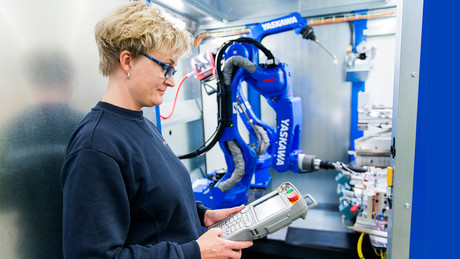Growth rate for new industrial robots predicted to hit 14% pa
Tuesday, 03 October, 2017

The International Federation of Robotics (IFR) is predicting that 1.7 million new robots will be installed in factories worldwide by 2020. The strongest growth in the robotics industry is in Asia, led by China as the world’s number one marketplace. In 2017 robot installations are estimated to increase by 21% in the Asia–Australia region. Robot supplies in the Americas will surge by 16% and in Europe by 8%. Important drivers of this development are the need for a response to faster business cycles and the requirement to produce with greater flexibility tailored to customer demand. A new generation of industrial robots will pave the way for ever more flexible automation.
“Robots offer high levels of precision and their connectivity will play a key role in new digital manufacturing environments,” said Joe Gemma, president of the International Federation of Robotics. “Increasing availability enables more and more manufacturers from companies of all sizes to automate.”
In terms of units, it is estimated that by 2020 the worldwide stock of operational industrial robots will increase from about 1,828,000 units at the end of 2016 to 3,053,000 units. This represents an average annual growth rate of 14% between 2018 and 2020. In Australasia the operational stock of robots is estimated to increase by 16% in 2017, by 9% in the Americas and by 7% in Europe. Since 2016, the largest number of industrial robots in operation has been in China. In 2020, this will amount to about 950,300 units, considerably more than in Europe (611,700 units). The Japanese robot stock will slightly increase in the period between 2018 and 2020. About 1.9 million robots will be in operation across Asia in 2020. This is almost equal to the global stock of robots in 2016.
There are five major markets representing 74% of the total sales volume in 2016: China, South Korea, Japan, the United States and Germany. China has significantly expanded its leading position as the largest market with a share of 30% of the total supply in 2016. With sales of about 87,000 industrial robots, China came close to the total sales volume of Europe and the Americas combined (97,300 units).
Industry 4.0 will play an increasingly important role in global manufacturing. As obstacles like system complexities and data incompatibility are overcome, manufacturers will integrate robots into factory-wide networks of machines and systems. Robot manufacturers are already developing and commercialising new service models based on real-time data collected by sensors which are attached to robots. Analysts predict a rapidly growing market for cloud robotics in which data from one robot is compared to data from other robots in the same or different locations. The cloud network allows these connected robots to perform the same activities. This will be used to optimise parameters of the robot’s movement such as speed, angle or force. Ultimately, the advent of big data in manufacturing could redefine the industry boundaries between equipment makers and manufacturers.
Some robot manufacturers are also considering leasing models, particularly in order to accelerate adoption by small to medium-sized manufacturers. Simplification is a key trend for this market segment. The ongoing need for robots that are easier to use and to program and the increasing need for ever more flexible automation initiated the development of smarter solutions.
China to invest 1 trillion yuan in robotics and high-tech industries
China's National People's Congress has announced a venture capital fund to expand...
Schneider Electric signs Motion Solutions as ANZ cobot distributor
Motion Solutions Australia and Motion Solutions New Zealand have been appointed as Schneider...
Top 5 robotics trends for 2025
The International Federation of Robotics has identified five key trends in robotics for 2025.








